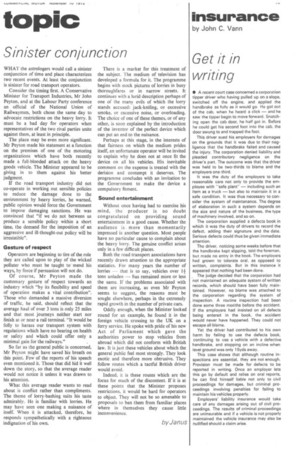insurance
Page 71

If you've noticed an error in this article please click here to report it so we can fix it.
by John C Vann
Get it in writing
• A recent court case concerned a corporation tipper driver who having pulled up on a slope, switched off the engine, and applied the handbrake as fully as it would go. He got out of the cab, when he heard a click — and he saw the tipper begin to move forward. Snatching open the cab door, he half got in. Before he could get his second foot into the cab, the door swung to and trapped the foot.
This driver sued his employers for damages on the grounds that it was due to their negligence that the handbrake failed and caused the injury. The corporation denied liability and pleaded contributory negligence on the driver's part. The outcome was that the driver was held to be two-thirds to blame and the employers one-third.
It was the duty of the employers to take reasonable care not only to provide the employee with "safe plant" — including such an item as a truck — but also to maintain it in a safe condition. It was thus necessary to consider the system of maintenance. The degree of elaboration in such a system depends on the size and nature of the business, the type of machinery involved, and so on.
The corporation supplied a defects book in which it was the duty of drivers to record the defect, adding their signature and the date. Serious defects could thus be given immediate attention.
The driver, noticing some weeks before that the handbrake kept slipping, told the foreman, but made no entry in the book. The employers had grown to tolerate oral, as opposed to written, complaints. But in this instance it appeared that nothing had been done.
The judge decided that the corporation had not maintained an adequate system of written records, which should have been fully maintained. However, no blame was attached to the corporation regarding the system of . inspection. A routine inspection had been done some three months before the accident. If the employers had insisted on all defects being entered in the book, the accident would never have happened. They could not escape all blame.
Yet the driver had contributed to his own harm by failing to use the defects book, continuing to use a vehicle with a defective handbrake, and stopping on an incline when level ground was only 1 5yds away.
This case shows that although routine inspections are essential, they are not enough. Provision must be made for defects to be reported in writing. Once an employer lets this go by default and relies on oral reports, he can find himself liable not only to civil proceedings for damages, but criminal proceedings involving penalties for failing to maintain his vehicles properly.
Employers' liability insurance would take care of any damages arising out of civil proceedings. The results of criminal proceedings are uninsurable and if a vehicle is not properly maintained the vehicle insurance may also be nullified should a claim arise.




































































































































